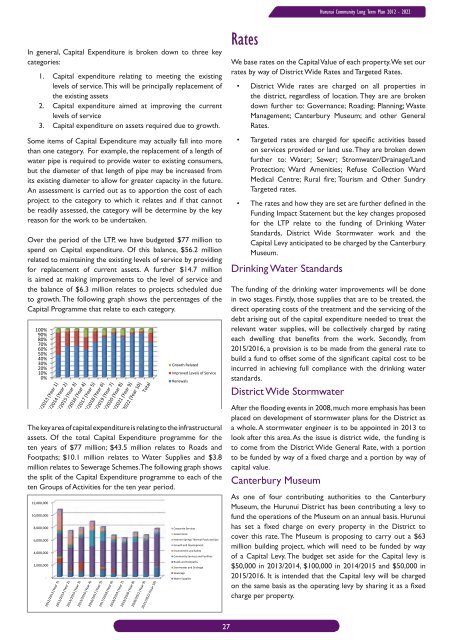Long Term Community Plan 2012-2022 - Hurunui District Council
Long Term Community Plan 2012-2022 - Hurunui District Council
Long Term Community Plan 2012-2022 - Hurunui District Council
You also want an ePaper? Increase the reach of your titles
YUMPU automatically turns print PDFs into web optimized ePapers that Google loves.
<strong>Hurunui</strong> <strong>Community</strong> <strong>Long</strong> <strong>Term</strong> <strong>Plan</strong> <strong>2012</strong> - <strong>2022</strong><br />
In general, Capital Expenditure is broken down to three key<br />
categories:<br />
1. Capital expenditure relating to meeting the existing<br />
levels of service. This will be principally replacement of<br />
the existing assets<br />
2. Capital expenditure aimed at improving the current<br />
levels of service<br />
3. Capital expenditure on assets required due to growth.<br />
Some items of Capital Expenditure may actually fall into more<br />
than one category. For example, the replacement of a length of<br />
water pipe is required to provide water to existing consumers,<br />
but the diameter of that length of pipe may be increased from<br />
its existing diameter to allow for greater capacity in the future.<br />
An assessment is carried out as to apportion the cost of each<br />
project to the category to which it relates and if that cannot<br />
be readily assessed, the category will be determine by the key<br />
reason for the work to be undertaken.<br />
Over the period of the LTP, we have budgeted $77 million to<br />
spend on Capital expenditure. Of this balance, $56.2 million<br />
related to maintaining the existing levels of service by providing<br />
for replacement of current assets. A further $14.7 million<br />
is aimed at making improvements to the level of service and<br />
the balance of $6.3 million relates to projects scheduled due<br />
to growth. The following graph shows the percentages of the<br />
Capital Programme that relate to each category.<br />
100%<br />
90%<br />
80%<br />
70%<br />
60%<br />
50%<br />
40%<br />
30%<br />
20%<br />
10%<br />
0%<br />
Growth Related<br />
Improved Levels of Service<br />
Renewals<br />
The key area of capital expenditure is relating to the infrastructural<br />
assets. Of the total Capital Expenditure programme for the<br />
ten years of $77 million; $43.5 million relates to Roads and<br />
Footpaths; $10.1 million relates to Water Supplies and $3.8<br />
million relates to Sewerage Schemes. The following graph shows<br />
the split of the Capital Expenditure programme to each of the<br />
ten Groups of Activities for the ten year period.<br />
12,000,000<br />
10,000,000<br />
8,000,000<br />
6,000,000<br />
4,000,000<br />
2,000,000<br />
-<br />
Corporate Services<br />
Governance<br />
Hanmer Springs Thermal Pools and Spa<br />
Growth and Development<br />
Environment and Safety<br />
<strong>Community</strong> Services and Facilities<br />
Roads and Footpaths<br />
Stormwater and Drainage<br />
Sewerage<br />
Water Supplies<br />
Rates<br />
We base rates on the Capital Value of each property. We set our<br />
rates by way of <strong>District</strong> Wide Rates and Targeted Rates.<br />
• <strong>District</strong> Wide rates are charged on all properties in<br />
the district, regardless of location. They are are broken<br />
down further to: Governance; Roading; <strong>Plan</strong>ning; Waste<br />
Management; Canterbury Museum; and other General<br />
Rates.<br />
• Targeted rates are charged for specific activities based<br />
on services provided or land use. They are broken down<br />
further to: Water; Sewer; Stromwater/Drainage/Land<br />
Protection; Ward Amenities; Refuse Collection Ward<br />
Medical Centre; Rural fire; Tourism and Other Sundry<br />
Targeted rates.<br />
• The rates and how they are set are further defined in the<br />
Funding Impact Statement but the key changes proposed<br />
for the LTP relate to the funding of Drinking Water<br />
Standards, <strong>District</strong> Wide Stormwater work and the<br />
Capital Levy anticipated to be charged by the Canterbury<br />
Museum.<br />
Drinking Water Standards<br />
The funding of the drinking water improvements will be done<br />
in two stages. Firstly, those supplies that are to be treated, the<br />
direct operating costs of the treatment and the servicing of the<br />
debt arising out of the capital expenditure needed to treat the<br />
relevant water supplies, will be collectively charged by rating<br />
each dwelling that benefits from the work. Secondly, from<br />
2015/2016, a provision is to be made from the general rate to<br />
build a fund to offset some of the significant capital cost to be<br />
incurred in achieving full compliance with the drinking water<br />
standards.<br />
<strong>District</strong> Wide Stormwater<br />
After the flooding events in 2008, much more emphasis has been<br />
placed on development of stormwater plans for the <strong>District</strong> as<br />
a whole. A stormwater engineer is to be appointed in 2013 to<br />
look after this area. As the issue is district wide, the funding is<br />
to come from the <strong>District</strong> Wide General Rate, with a portion<br />
to be funded by way of a fixed charge and a portion by way of<br />
capital value.<br />
Canterbury Museum<br />
As one of four contributing authorities to the Canterbury<br />
Museum, the <strong>Hurunui</strong> <strong>District</strong> has been contributing a levy to<br />
fund the operations of the Museum on an annual basis. <strong>Hurunui</strong><br />
has set a fixed charge on every property in the <strong>District</strong> to<br />
cover this rate. The Museum is proposing to carry out a $63<br />
million building project, which will need to be funded by way<br />
of a Capital Levy. The budget set aside for the Capital levy is<br />
$50,000 in 2013/2014, $100,000 in 2014/2015 and $50,000 in<br />
2015/2016. It is intended that the Capital levy will be charged<br />
on the same basis as the operating levy by sharing it as a fixed<br />
charge per property.<br />
27

















